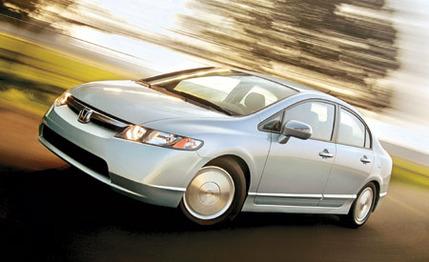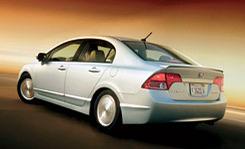 Road Test
Road Test
Hybrids seem to be having the same impact the Volkswagen Beetle had on our society back in the '60s and '70s. Hybrids are seen as anti-establishment symbols, the anti-status status symbol. But there has been some discontent with these feel-good cars as owners have found they're not getting the advertised mileage. So if you're on the verge of being overcome by the environmentally correct need to get behind the wheel of a hybrid, be advised that they don't all work in the same way. You'll need to curb some of your speedy habits and learn some new driving skills to achieve their fuel-economy claims.
In a hybrid, the trick is to drive like a grandmother. You have to accelerate away from a stop slowly enough to minimize the role of the gasoline engine and maximize the role of the electric motor. Very simply, hybrids use an electric motor as a supporting source of power that doesn't require gasoline, and that's the whole point. Indeed, a Toyota Prius can pull away from a stop using only its electric motor, although the Civic hybrid shown here cannot.
There are two major reasons why the Civic can't do that. First, it has a weakling 20-hp electric motor, whereas the Prius's makes a robust 67 horses, so it's better able to move almost 3000 pounds off a dime. Second, the Honda's engine and electric motor are sandwiched together and then connected to the transmission, so if one is running, so is the other. The Prius's electric motor and gas engine, on the other hand, are hooked up at separate points to the transmission, and therefore, one power source can be driven while the other is shut off. The Toyota system makes electric-only driving easy and is the primary advantage of that configuration. Honda's hybrid system is more simple and compact and is more easily adaptable than the Toyota system to different vehicles.
Interestingly, although the Civic can't move away from a stop using only the electric motor, Honda says there is one situation where its hybrid can run on just electricity--at about 15 to 20 mph when cruising on a flat surface at a steady speed with a fully charged, or nearly so, battery pack. Since the electric motor and the gas engine rotate inseparably, the Civic must cut off fuel to the engine and use its variable-valve-timing system to close the engine's valves and make it easier for the electric motor to do its job. The Civic's only giveaway that it's running on electricity alone is the digital bar graph that lights up suddenly when juice is being sent to the motor. So it might not have the beans to get the Civic going from a stop, but the 20-hp electric motor does have enough gusto to keep the car moving at low speeds--all by itself, if only briefly. However, it's such a short span of time under such specific and not-often-encountered conditions that the fuel savings are likely minuscule. Honda probably makes the claim to equal those of its major rival hybrid, the Prius.
 The second big trick that hybrids can do is recharge their own batteries. The recharging occurs when you lift off the throttle, when you hit the brakes, or when cruising if the computer determines that the battery needs charging. When you get off the gas in a hybrid, the primary source of deceleration is the electric motor, not the gas engine as in a conventional car. Moreover, the hybrid uses a special electric motor that can also operate as a generator. Send this electric motor electricity, and it will produce power; rotate it using external forces, and it will produce electricity. Using the car's momentum to spin this motor, therefore, creates electricity, which is sent back to the battery pack. That's called regenerative braking. Hitting the brakes lightly will cause the electric motor to resist motion further, and in doing so, even more electricity is produced to send to the batteries.
The second big trick that hybrids can do is recharge their own batteries. The recharging occurs when you lift off the throttle, when you hit the brakes, or when cruising if the computer determines that the battery needs charging. When you get off the gas in a hybrid, the primary source of deceleration is the electric motor, not the gas engine as in a conventional car. Moreover, the hybrid uses a special electric motor that can also operate as a generator. Send this electric motor electricity, and it will produce power; rotate it using external forces, and it will produce electricity. Using the car's momentum to spin this motor, therefore, creates electricity, which is sent back to the battery pack. That's called regenerative braking. Hitting the brakes lightly will cause the electric motor to resist motion further, and in doing so, even more electricity is produced to send to the batteries.
The Civic has a digital display that shows how much electricity you're sending to the battery or how much you're using up. Brake moderately hard, and you'll light up the maximum number of green LEDs. Hit the brake pedal harder, and you'll activate the conventional brakes, just as you would in any other car. It's a challenge to send the maximum amount of charge without employing the traditional brakes.
The final benefit of a hybrid is that the gas engine shuts off when you come to a full stop, thereby saving fuel. In the first Civic hybrid, if the air conditioning was on and the econ button was not engaged, the engine wouldn't shut down. This latest hybrid solves that problem by adding an electric-motor-driven portion to the A/C compressor. So, at a stop, the electric compressor keeps the cabin cool. As soon as you lift your foot off the brake, the gas engine whirs to life again.
The EPA testifies that the Civic hybrid gets 49 mpg in city driving and 51 on the highway. But those numbers are rarely achieved. To get mileage in the high-40-mpg range requires gradual acceleration, timid cruising speeds, and cautious use of the throttle. Suffer a short lapse in concentration or accelerate immoderately, and fuel economy will suffer. Fact is, to do this right, you will drive more slowly than you ever have.